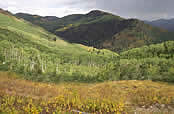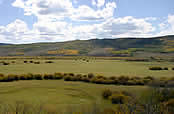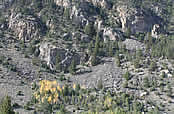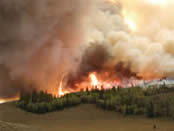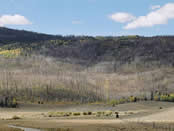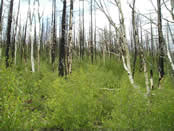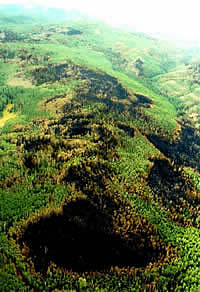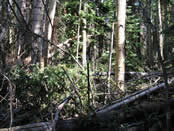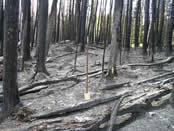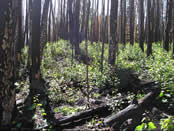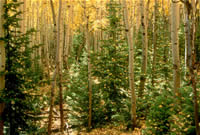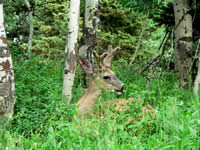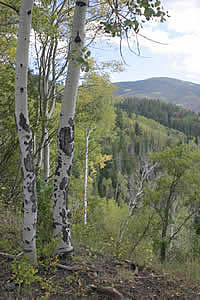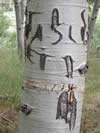USDA Forest Service Celebrating Wildflowers
|
|
|
 |
|
Aspen EcologyAspen grows in a wide range of environmental conditions, from moist streamsides, to dry ridges, on talus slopes, in shallow to deep soils of various origins, and is tolerant of wide variations in climate. It is found in all mountain vegetational zones, from the basal plains of the mountains to the alpine. As a result, aspen communities are found associated with a diverse range of vegetation, from semi-arid shrublands to wet, spruce-fir forest.
Aspen may be a dominant seral tree in a community as the climax species, usually conifers, regain dominance; or, aspen may be a climax tree in a stable aspen community. These stable aspen communities are characterized by an uneven age structure, lack of successional change, and the absence of more shade tolerant trees. They seem to be self-perpetuating without the need for rejuvenating disturbance such as fire. Role of FireFire is a natural feature in much of the aspen ecosystem of western North America. It is responsible for the abundance of aspen in the West and for the even-aged structure of most stands. In some areas, many aspen stands are the same age, dating from a single great fire or a year of widespread fires. Fire appears to be necessary for the continued well-being of aspen on most sites. Many aspen stands are replaced by grass, forbs, shrubs, or conifers in the absence of fire.
Aspen is considered a fire-induced successional species that will dominate a site until it is replaced by less fire-enduring and more shade-tolerant species, such as conifers; provided a coniferous seed source is present. Fire reduces the overstory, stimulates shoots to sprout, and kills invading conifers growing in the aspen clone. Since aspen can sprout from existing roots and these suckers grow faster than the new slowing growing conifers, aspen can dominate in a grove for many years after a fire. Otherwise, aspen can be replaced relatively quickly by conifers, within 100-200 years, or the replacement may be slower taking more than 1,000 years. Aspen forest does not readily burn. Aspen trees have moist green leaves and thick twigs that do not burn easily, unlike conifers, which have dry needles and twigs. Crown fires running through coniferous forest drop to the ground when they come to an aspen stand and may even extinguish after burning into the aspen only a few yards. Fires sometimes bypass stands of aspen enclosed within coniferous forest. Although aspen forests do not burn readily, aspen trees are extremely sensitive to fire. A fire intense enough to kill the aspen overstory will stimulate abundant suckering, though some suckers arise after any fire. As many as 50,000 to 100,000 suckers can sprout and grow on a single acre after a fire. NOTE: The video content presented here requires JavaScript to be enabled and the latest version of the Adobe Flash Player. If you are you using a browser with JavaScript disabled please enable it now. Otherwise, please update your version of the free Flash Player. Watch the aspen grove burn and sprout again. Over time, the aspen suckers in a grove that emerge following a fire will slowly thin themselves. After 20 or 30 years, the aspen grove will have just about as many aspen trees as it did before the fire. As the aspen grove returns to the burned area, so do the plants and animals that depend upon them for their habitat.
If fire occurs at infrequent intervals (e.g., 50 years) and is moderately intense enough to kill most or all of the aspen and competing conifers, most aspen sites in the West will retain viable stands of aspen. More frequent fires may adversely affect site quality for aspen. Complete fire protection, however, will permit coniferous species to take over the majority of sites. AnimalsThe aspen ecosystem is rich in number and species of animals, especially in comparison to associated coniferous forest types. The aspen forest type produces an abundance of forage, as much as many grasslands and more than 10 times that produced under associated conifers. Cattle and sheep grazing the aspen understory has been the primary consumptive use of the aspen forest in the West. Browsing has a direct impact on aspen trees in this forest community. Through the early sapling stage, browsing reduces aspen growth, vigor, and numbers. Heavy browsing by large ungulates such as deer, elk, or sheep can drastically reduce or eliminate aspen sucker regeneration. Beaver can effect aspen from cutting, dam building, and flooding. Beaver have the ability to cut and remove saplings to mature-sized aspen trees. Cutting, by itself, stimulates abundant aspen suckering. Beaver cut aspen of all diameters, feed on the bark and small branches of the felled trees, and utilize stems of medium diameter in their dams. The flooding resulting from the beaver dams may change the entire plant community, and even the landscape. A series of benches may result from siltation behind beaver dams. Each bench is relatively flat and wet along the stream course, often too wet for aspen to develop. These benches may be dominated by other vegetation for centuries.
Aspen is especially susceptible to gnawing or stripping of its bark by several species of mammals, such as elk, deer, rabbits, hares, mice, voles, and porcupines. Aspen buds are an important winter food source for wildlife. Aspen seedlings and saplings may also be trampled by livestock and large ungulates. Aspens may be effected by digging and feeding upon their roots by pocket gophers and other burrowing creatures. InsectsQuaking aspen appears to be host to several insect and other invertebrate pests. Some are quite damaging and may kill otherwise healthy stands of aspen. Others feed on weakened or dying trees and still others have incidental impacts. Insect species that feed on aspen include several defoliator insects, borers, leaf miners, sawflies, leafhoppers, and aphids. DiseaseAlthough many diseases attack aspen, relatively few kill or seriously injure living trees. Generally, the common leaf diseases are found throughout the range of aspen, while decay fungi and major canker-causing organisms are more locally distributed. Much remains to be learned of the disease organisms that infect aspen. Physical FactorsAspen is affected by a variety of physical and mechanical factors as well. As aspen is very intolerant of shade, the lack of light may affect tree vigor and regeneration. Mature aspen trunks may sunscald if they are abruptly exposed to large increases in sunlight. Wind can sometimes severely impact an aspen grove as would a severe forest fire. Trees are blown down and broken, the area is opened up, and aspen suckering is stimulated. Snowstorms may do extensive damage to aspen if the snow is wet and clings to the aspen crowns. Limbs may break, sapling to pole size trees may be broken off, bent to the ground, and sometimes partially uprooted. Weather-related phenomenon, such as hail and lightning, temperature extremes, and drought may damage aspen. |
|
| NOTE: PDF format links require the Adobe Acrobat Reader to view. | |
| top | Disclaimers | FOIA | Privacy Policy | Quality of Information | Photo Credits & Use |
Location: http://www.fs.fed.us/wildflowers/communities/aspen/ecology.shtml
Last modified: Tuesday, 24-Jun-2008 21:53:15 EDT
